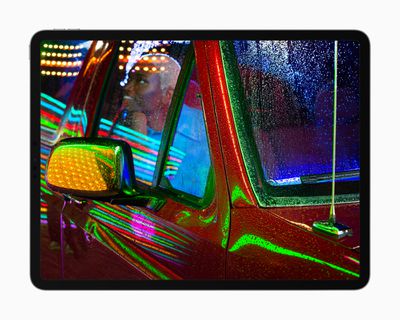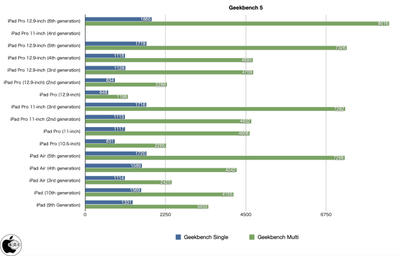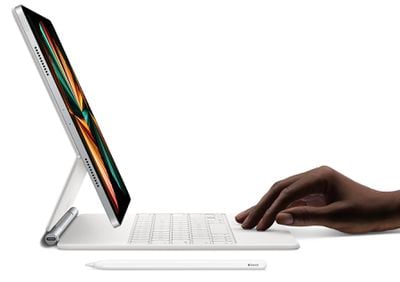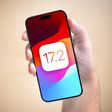Apple's latest iPad Air and iPad Pro models feature similar designs, Liquid Retina displays, M-series chips, 5G connectivity, and much more in common – so which should you buy?

The introduction of the previous, fourth-generation iPad Air in September 2020 brought the device much closer to the iPad Pro in terms of design, and with the most recent model, the iPad Air gained the same M1 chip as the previous iPad Pro, bringing them even closer together. The latest iPad Pro models introduced a relatively small number of new features, such as the M2 chip, Apple Pencil hover, Wi-Fi 6E, and Bluetooth 5.3, but it means that the high-end iPad models are now differentiated a little more from the iPad Air model that Apple unveiled in March 2022.
Should you consider purchasing the iPad Air to save money, or do you need the high-end features of the iPad Pro? Our guide answers the question of how to decide which of these two iPads is best for you.
Comparing the iPad Air and iPad Pro
The iPad Air and iPad Pro share a large number of key features, such as an all-screen design with flat sides, a 12MP rear Wide camera, a 12MP front-facing Ultra Wide camera, and a USB-C port:
Similarities
- Industrial design with flat edges
- Liquid Retina display with 264 ppi, full lamination, oleophobic and anti-reflective coating, P3 Wide Color, and True Tone
- M-series chip with next-generation Neural Engine
- 5G connectivity
- ƒ/1.8 12MP Wide rear camera, with digital zoom up to 5x for photos
- ƒ/2.4 12MP front-facing Ultra Wide camera with 2x optical zoom out and Center Stage
- 4K video recording at up to 60 fps, extended dynamic range for video up to 30 fps, 3x video zoom, slo-mo video support for 1080p at up to 240 fps, and time-lapse video with stabilization
- "All-day" 10 hour battery life
- USB‑C connector
- Compatible with Magic Keyboard, Smart Keyboard Folio, and Apple Pencil (2nd generation)
Apple's specification breakdown shows that the two iPads share many of their most important features. Even so, there are an even larger number of meaningful differences between the iPad Air and iPad Pro that are worth highlighting, including their displays, authentication technologies, and rear camera setups.
Key Differences
| iPad Air | iPad Pro |
|---|---|
| Touch ID built into the top button | Face ID enabled by TrueDepth camera |
| 10.9-inch display | 11-inch or 12.9-inch display, with 120Hz ProMotion technology |
| Liquid Retina LED display | Liquid Retina LED display (11-inch) or Liquid Retina XDR mini-LED display (12.9-inch) |
| 500 nits max brightness (typical) | 600 nits max brightness (11-inch) or 1,000 nits max brightness and 1,600 nits peak brightness (12.9-inch) |
| – | Apple Pencil hover |
| M1 chip with 8-core, 3.2GHz CPU and 8-core GPU | M2 chip with 8-core, 3.49GHz CPU and 10-core GPU |
| Neural Engine | 40 percent faster Neural Engine |
| Media engine for hardware-accelerated H.264 and HEVC | Media engine for hardware-accelerated H.264, HEVC, ProRes, and ProRes RAW |
| Video encode and decode engine | Higher-bandwidth video decode engine |
| – | ProRes encode and decode engine |
| Image signal processor (ISP) | "New" image signal processor (ISP) |
| 8GB of memory | 8GB or 16GB of memory |
| 68.25GB/s memory bandwidth | 100GB/s memory bandwidth |
| Bluetooth 5.0 | Bluetooth 5.3 |
| Wi‑Fi 6 | Wi‑Fi 6E |
| Sub-6GHz 5G connectivity | Sub-6GHz and mmWave 5G connectivity |
| ƒ/1.8 12MP Wide rear camera | ƒ/1.8 12MP Wide and ƒ/2.4 10MP Ultra Wide rear cameras |
| Smart HDR 3 | Smart HDR 4 |
| – | True Tone flash |
| – | ProRes video recording up to 4K at 30 fps |
| Digital zoom up to 5x | Digital zoom up to 5x and 2x optical zoom out |
| 3x video zoom | Video zoom up to 3x and 2x optical zoom out |
| – | Audio zoom |
| – | LiDAR scanner |
| ƒ/2.4 12MP Ultra Wide front-facing camera with 2x optical zoom out and Center Stage | ƒ/2.4 12MP TrueDepth Ultra Wide front-facing camera with 2x optical zoom out, Center Stage, Portrait Mode, Portrait Lighting, Animoji, and Memoji |
| – | Stereo recording |
| Two speaker audio landscape mode | Four-speaker audio |
| USB‑C connector | USB‑C connector with support for Thunderbolt/USB 4 |
| Up to 256GB storage | Up to 2TB storage |
| Available in Space Gray, Starlight, Pink, Purple, and Blue | Available in Silver and Space Gray |
| Price starting at $599 | Price starting at $799 |
Read on for a closer look at each of these aspects, and see what exactly both iPads have to offer.
Design
Both the iPad Air and the iPad Pro use Apple's most recent all-screen product design language, also seen on the iPhone 12, iPhone 13, and iPhone 14 lineups, the iPad mini, and 10th-generation iPad, featuring industrial squared-off edges and flat sides.

The 10.9-inch iPad Air is almost exactly the same size as the 11-inch iPad Pro, despite having a smaller display, resulting in it having slightly thicker bezels around the screen.
Although the design of the two iPad models is similar, the iPad Air is available in a wider range of colors. The iPad Air is available in Space Gray, Starlight, Pink, Purple, and Blue, while the iPad Pro is only available in Silver and Space Gray.
Authentication
A key difference between the iPad Air and iPad Pro is authentication technology. The iPad Air features Touch ID, while the iPad Pro features Face ID.

The iPad Air has a Touch ID fingerprint scanner embedded in the iPad's top button. The iPad Pro's Face ID is facilitated by the TrueDepth camera array in the top bezel.

Unlocking is something that may be used dozens of times every day, so it is important to choose your preferred method of authentication if you feel particularly strongly about it. That being said, both Touch ID and Face ID are now refined technologies that work well, and most users will probably be happy with whichever they have.
Displays
Display Sizes
The iPad Air features a 10.9-inch display, while the iPad Pro has the option of either an 11-inch display or a 12.9-inch display.

The difference in screen size between the 10.9-inch iPad Air and the 11-inch iPad Pro is virtually negligible. These models are around half a pound lighter than the 12.9-inch iPad Pro and will be best for users focused on portability and easy handheld use.
The 12.9-inch iPad Pro, on the other hand, is best for users who are intending to use their iPad more like a laptop, likely on a table or with a keyboard accessory such as the Magic Keyboard. In particular, multitasking is a much better experience on the 12.9-inch iPad Pro's large display.

Display Technologies
Both the iPad Air and the 11-inch iPad Pro feature Liquid Retina LED displays with 264 ppi, full lamination, oleophobic and anti-reflective coatings, P3 Wide Color, and True Tone. The 11-inch iPad Pro can get 100 nits brighter than the iPad Air and features ProMotion technology for up to 120Hz refresh rates.

The biggest advancement in display technology is available with the 12.9-inch iPad Pro. This model has all of the display features included with its smaller sibling, including 120Hz ProMotion, but uses a fundamentally different underlying display technology: mini-LED.
Apple calls the 12.9-inch iPad Pro's mini-LED screen a "Liquid Retina XDR display." Mini-LED allows the 12.9-inch iPad Pro to reach up to 1,000 nits full-screen brightness, 1,600 nits peak brightness, and a 1 million-to-1 contrast ratio. The display can reflect what can be seen in the real world by capturing the brightest highlights and subtle details in even the darkest images, allowing users to view and edit true-to-life HDR and Dolby Vision content, which is especially important to creative professionals, including photographers, videographers, and filmmakers.
The iPad Air's Liquid Retina display will be sufficient for the vast majority of users, but some may prefer the responsiveness of ProMotion on the iPad Pro for tasks such as gaming. The 12.9-inch iPad Pro's high-end Liquid Retina XDR display, on the other hand, is best for users who consume a lot of HDR content, creative professionals, and those who want the best possible display.
M1 vs. M2
Both the iPad Pro and iPad Air offer a high level of performance, but the iPad Pro features the M2 chip – Apple's latest custom silicon chip primarily designed for the Mac, enabling ProRes video recording and media acceleration for the first time on an iPad.

Apple says that the M2 chip takes the performance per watt of the M1 even further with an 18 percent faster CPU, a 35 percent more powerful GPU, and a 40 percent faster Neural Engine.
Mac Otakara shared Geekbench 5 results for the new iPad Pro that confirm about a 15 to 16 percent increase in multi-core performance over the previous model (8,516 score for 12.9-inch model with M2 chip vs. 7,326 for the 12.9-inch model with M1 chip):

Regardless, both of the chips are Mac-class and offer a high level of performance that should be able to meet most users' needs, with more meaningful advancements being reserved for ProRes workflows.
Memory
The iPad Air has 8GB of RAM, while the iPad Pro has either 8GB or 16GB, depending on which storage configuration you choose. iPad Pro configurations with either 1TB or 2TB of storage contain 16GB of RAM, while all other storage configurations contain 8GB of RAM. 8GB in the iPad Air will be adequate for casual users, but 16GB will be better at handling multiple windows of the same application and a range of intense background tasks.
Ultimately, iPadOS is very good at memory management and it is questionable how far apps can take advantage of extra memory, so it is unlikely that the amount of RAM in your iPad will be important in most cases.
Storage
The iPad Air offers the option of either 64GB or 256GB storage, while the iPad Pro offers 128GB, 256GB, 512GB, 1TB, or 2TB. The maximum 256GB of storage in the iPad Air will be enough for many users, but for those power users who intend to store a large amount of data on their iPad, the option is available with the iPad Pro.
Cameras
Rear Cameras
A major area of difference between the two iPad models is their camera setups. The iPad Air features a single ƒ/1.8 12MP Wide camera. The iPad Pro has the same ƒ/1.8 12MP Wide camera as the iPad Air, but also adds a ƒ/2.4 10MP Ultra Wide camera and a LiDAR scanner.

As well as being able to zoom in digitally five times, the iPad Pro can also optically zoom out up to two times, thanks to its Ultra Wide lens. The iPad Pro can record 4K ProRes video, and also features a True Tone flash.

LiDAR allows the iPad Pro to measure the distance to surrounding objects up to five meters away, operating at the photon level at nano-second speed. This makes the iPad Pro capable of a "new class" of improved AR experiences with better motion capture, understanding of the environment, and people occlusion.
Users who like to use their iPad as a large viewfinder for photography or heavy users of AR will appreciate the iPad Pro's more advanced camera setup, but for the majority of users who do not use the iPad's rear camera very often, the iPad Air's single Wide camera is more than good enough.
Front-Facing Cameras
Both the iPad Air and the iPad Pro have a ƒ/2.4 12MP Ultra Wide front-facing camera with 2x optical zoom out. The iPad Pro's TrueDepth camera also enables Portrait mode, and Portrait Lighting, Animoji, and Memoji.
Both devices offer Center Stage for video calls with the front-facing camera. Center Stage uses the iPad's larger field of view and the machine learning capabilities of the M1 and M2 chip to recognize and keep users centered in the frame. As users move around, Center Stage automatically pans to keep them in the shot. When others join in, the camera detects them too, and smoothly zooms out to fit everyone into the view.
Other than Portrait mode, and Portrait Lighting, Animoji, and Memoji, the two front-facing camera setups are identical and there is no reason to get one over the other.
Speakers and Microphones
The iPad Air has two-speaker audio in landscape mode, while the iPad Pro has wider four-speaker audio. If you use your iPad for consuming lots of music and videos with the built-in speakers, the iPad Pro will deliver a slightly better experience.
The iPad Pro can record audio in stereo and features "studio-quality" mics, which may be important for some users who record music or lectures using their iPad. Even so, the iPad Air has a proficient speaker and microphone setup that will be sufficient for most users.
Wireless Connectivity
The iPad Pro betters the wireless connectivity specifications of the iPad Air with Wi-Fi 6E, Bluetooth 5.3, and mmWave 5G in the United States. Wi-Fi 6, Bluetooth 5, and sub-6GHz 5G on the iPad Air will realistically be sufficient for most users, but if you have distinct needs for better specifications in this area, such as a high-speed 5G cellular connection in the United States, the iPad Pro could be a more worthwhile choice.
Ports
The iPad Air features a standard USB-C port, while the iPad Pro features a Thunderbolt port. USB-C on the iPad Air can transfer at a speed of 10Gb/s, while Thunderbolt supports speeds of up to 40Gb/s. As well as being considerably faster, Thunderbolt opens up the potential for compatibility with a much broader range of Thunderbolt-only accessories such as external hard drives and monitors. Thunderbolt also is backward-compatible with USB-C, so the two ports look identical.

Even though Thunderbolt is much faster than the iPad Air's standard USB-C port, most users likely do not have Thunderbolt accessories that can take advantage of these speeds. For this reason, the iPad Air is again the best option for most people in terms of port options.
Accessories
Both the iPad Air and iPad Pro support accessories such as the Apple Pencil 2, as well as Apple's Smart Keyboard Folio and Magic Keyboard. Since they both support the same accessories, there is no reason to buy one model over the other when it comes to the likes of keyboards or trackpads.

Apple Pencil hover is a new, iPad Pro-exclusive feature that allows for cursor-like interaction when the Apple Pencil is brought close to the screen. As such, this may be an important factor for keen illustrators, note-takers, and Apple Pencil enthusiasts.
It should also be considered that accessories such as the Apple Pencil and Magic Keyboard have to be purchased separately from the iPad, so will push up the overall price. Therefore, if the iPad Pro, which starts at $799 for the 64GB 11-inch model, is already moving out of your price range and you want an accessory such as the $299 Magic Keyboard, you may need to opt for the iPad Air, which starts at $599, to bring down the overall cost.
Other iPad Options
If the iPad Air is too expensive at $599, you may want to consider the 10th-generation iPad, which starts at $449. This iPad has a 10.9-inch display, the A14 Bionic chip, 4GB of memory, Center Stage, and is compatible with accessories such as the Magic Keyboard Folio and the first-generation Apple Pencil. While it lacks features like a laminated display, the M1 chip, and 8GB of memory, the 10th-generation iPad is a great alternative to the mid to high-end iPads, offering a balanced mix of features.
- iPad 10 vs. iPad Air Buyer's Guide: Is the $150 Difference Worth It?
- iPad Air 5 vs. iPad Mini 6 Buyer's Guide
On the other hand, if you are looking for the smallest, most portable iPad, you should consider the iPad mini, which features a smaller 8.3-inch display and the A15 chip, for $499.
Final Thoughts
Overall, the iPad Air is the better option for the majority of users, simply on the basis of value for money. For most people, the additional $200+ needed to buy the iPad Pro will not be justified to get the likes of Face ID, a more versatile rear camera system, four-speaker audio, a ProMotion display with refresh rates up to 120Hz, and Apple Pencil hover.
Some iPad Pro features, such as LiDAR, the Ultra Wide rear camera, larger storage options and up to 16GB of memory, and Thunderbolt connectivity, will only be practically useful to a small niche of iPad users and most users will never use some of these high-end features. Many features such as the True Tone flash, mmWave 5G connectivity in the U.S., Audio zoom, and stereo audio recording may not be meaningfully utilized by many users.
Professionals who have a clear use case for needing larger amounts of RAM and storage, Thunderbolt connectivity, and mini-LED for HDR content will benefit from buying the iPad Pro. Prosumers will also enjoy features such as 120Hz ProMotion for smoother scrolling and gaming, deeper blacks and more vivid colors with the mini-LED display, and LiDAR for AR experiences, even if they are not necessary, and those who want a larger 12.9-inch display for content consumption or better multitasking will similarly need to go with the higher-end iPad Pro model.
Prosumers and professionals who want the iPad to replace their laptop or computer should likely choose the 12.9-inch iPad Pro if they are pairing it with the Magic Keyboard due to the added screen space for multiple applications. This larger iPad Pro is considerably different to the iPad Air, setting itself apart with mini-LED and a much larger display.
Beyond these individual circumstances, the iPad Air is the best option and will be more than ample for most users' needs. With the iPad Air, users can get an all-screen design, the M1 chip, practical features like USB-C and 5G connectivity, and compatibility with the core Apple accessories.























Top Rated Comments
If you wan the 10th Gen iPad buy a refurbished 4th Gen iPad Air (same chip, better display, 2nd gen Pencil, lower quality front facing camera).